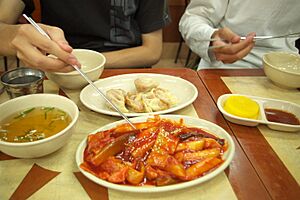Bunsik facts for kids
| Bunsik | |
 |
|
Quick facts for kids Korean name |
|
|---|---|
| Hangul |
분식
|
| Hanja |
粉食
|
| Revised Romanization | bunsik |
| McCune–Reischauer | punshik |
| IPA | [pun.ɕik̚] |
Bunsik (분식; 粉食) is a fun word for popular and affordable Korean dishes. You can find these tasty foods at special snack restaurants called bunsikjeom (분식점) or bunsikjip (분식집).
The word bunsik originally meant "food made from flour." So, things like ramyeon (noodle soup) and bread were considered bunsik. Today, the meaning is much wider! It includes many other dishes served at these snack places. These foods are usually big portions and don't cost much. Some popular bunsik items are gimbap, tteokbokki, ramyeon, rabokki (which is tteokbokki with ramyeon), sundae, eomuk, and twigim. A famous bunsikjip chain in Korea is "Gimbap-Cheonguk," meaning "Gimbap Heaven." Many snack bars in Korea sell everything from quick bites to full meals.
Bunsik's Story: A Look Back
In the 1960s, South Korea didn't have much rice. The government wanted people to eat other foods instead. So, they encouraged everyone to try bunsik!
- Groups were set up in different areas to help.
- Schools, government offices, and public places led the way.
- Restaurants were asked to use more barley and wheat flour.
- Selling rice-based foods was even banned on certain days of the week.
- Restaurants in official buildings couldn't sell rice dishes at all!
This effort to promote bunsik lasted until 1976. It helped people discover new, delicious, and affordable meals.
See also

- In Spanish: Bunsik para niños

